This Wednesday (17 May 2017) marks an important milestone in the development of offshore wind. It is significant for the international energy sector, U.K. energy and economic policy and Liverpool City Region.
It involves a company few people in the UK had heard of, a technology that until recently was considered by some as expensive and unreliable and a City Region determined to exploit its geographic and historical position to maximise the benefits from this new opportunity.
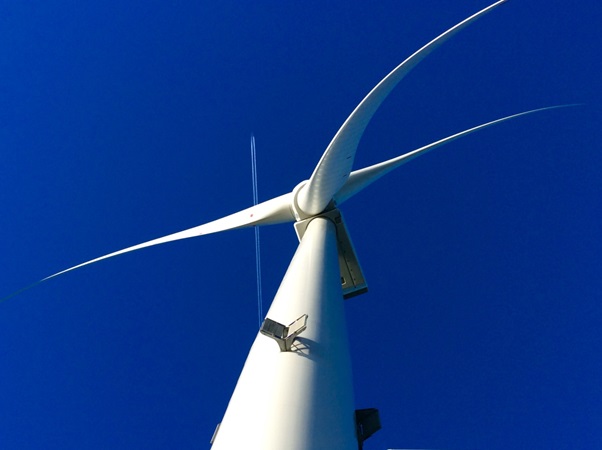
Mitsubishi Vestas V164 Turbine, Burbo Bank Extension, Liverpool Bay
Wednesday sees the inauguration by DONG Energy and its investment partners, Lego Group and PKA of the new Burbo Bank Extension offshore windfarm in Liverpool Bay. This is the latest in a series of new offshore windfarms that has put the UK at the forefront of offshore wind development. Over 50% of total global investment in offshore wind over the last five years has been committed to U.K. territorial waters. With the completion of Burbo Bank Extension, Liverpool Bay now has five operational windfarms with over 270 turbines. In comparison, the USA, at present, has five operational turbines in total. The UK presently has a clear international lead in offshore wind investment. This is set to change with other European countries and new markets such as the USA, China, South America and Taiwan set to expand rapidly in the coming years.
Investment in U.K. windfarms has been predominantly from overseas investors. The five windfarms in Liverpool Bay have investors including German and Danish utility companies (RWE and DONG Energy), German municipal utility companies (Stadtwerke Munchen), German technology companies (Siemens) and latterly on Burbo Bank Extension, a Danish pension company (PKA) and Lego Group. It is interesting to note the relative absence of U.K. Institutional investors which is largely replicated across the U.K. energy investment portfolio. There is a clear correlation between country of origin for investors and the relative longevity and experience of renewables, especially wind, these countries have.
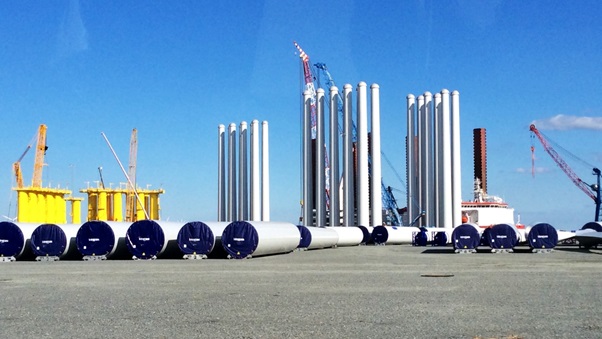
Offshore wind components load-out facility, Esbjerg, Denmark
Investors in any infrastructure need a competitive rate of return. Offshore wind is a comparatively young industry. The very first offshore windfarm, situated off the Danish coast was decommissioned in April after 25 years in service. Our first windfarms in the UK and Liverpool Bay at Burbo Bank, North Hoyle and Rhyl Flats are around ten years old. The industry has had a decade to go from a niche, handmade, industry with a high cost base and reliant on government support to one that has industrialised its supply chain with a focus on cost reduction to meet reducing subsidies whilst still providing attractive returns to investors.
New technology and techniques have formed the cornerstone of this transition. The first deployment of the Siemens 3.6MW turbines that were to go on to be an industry stalwart were installed at Burbo Bank ten years ago. A decade later, Burbo Bank Extension is once again leading the way with its Mitsubishi Vestas 8.0MW turbines. These new turbines are the largest in the world. For context, each turbine is the equivalent in scale to the Gherkin Tower in London with the London Eye on top of it. They are twice the height of the Liver Building. Each blade is 84m. An A380 super jumbo total wingspan is 74m. These new machines are at the leading edge of technology.
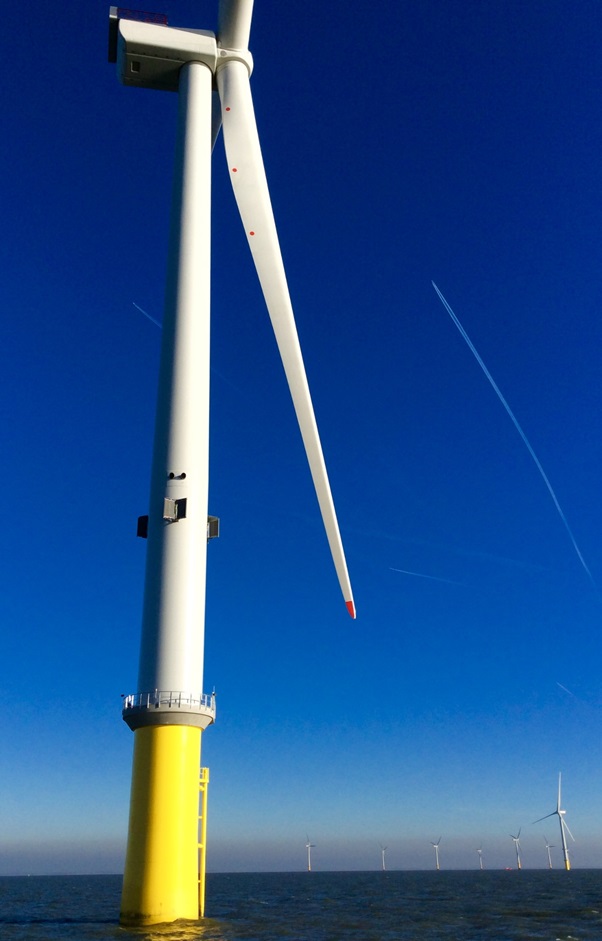
Burbo Bank Extension windfarm, Liverpool Bay
They are adapting technologies from the oil and gas and particularly the aerospace sector. The offshore wind industry set itself a cost reduction target based on a £/MWh calculation. This 2020 target was achieved earlier this year. This dramatic cost reduction has come from innovation within the supply chain, greater standardisation and larger markets driving economies of scale. The reduced installation and operation costs for offshore wind has had the effect of making the sector cost competitive against other forms of generation. Liverpool City Region companies have been at the forefront of this push through innovative products and techniques, brought from other sectors then honed and refined for offshore wind.
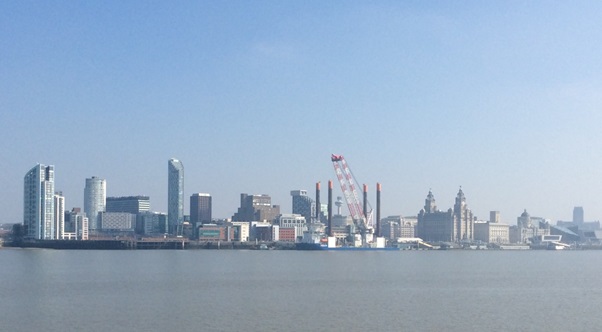
Wind Turbine Installation Vessel
So, a growing industry, record investment, new technologies. Everything looks rosy. Everything maybe except, one critical issue: The level of UK and local content in these windfarms.
The first offshore wind turbines were developed in the North East at Blyth some thirty years ago. But the industry did not take root in the UK at that time. German and Danish companies understood the opportunity and further developed the new products and services the industry required, despite the fact that the UK has the best wind resource in Europe. It wasn’t long before boats carrying Danish and German product and workers could be seen in Liverpool Bay as the UK Government, through the Crown Estate, started licensing development zones for offshore wind in UK waters. Ten years ago, as the first farms went into Liverpool Bay, things were done for us, rather than by us. There was very little UK, never mind Liverpool City Region content in the turbines or assembly. Six years ago, the LEP’s predecessor commissioned a report from Arup to assess the opportunities from offshore wind for Liverpool City Region. Whilst broadly positive, it stressed the need to develop a sustainable, local supply chain.
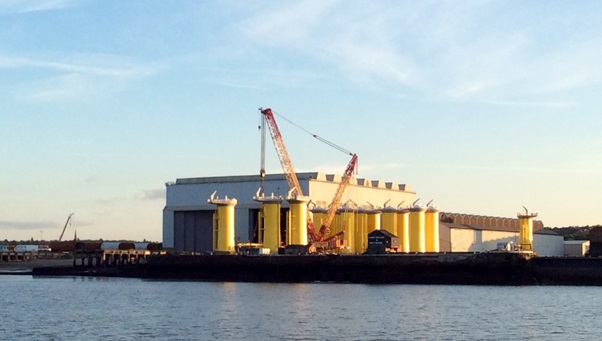
Transition Pieces for Burbo Bank Extension awaiting loading at Cammell Laird
This approach chimed with emerging thinking nationally at the time and more recently we have seen the trialled introduction of UK Supply Chain Plans into two critical infrastructure projects. Burbo Bank Extension and the Inter City Express train project. DONG Energy and Hitachi were encouraged to maximise the total contract value that went to UK companies on the two projects. On Burbo Bank this more focused approach has resulted in main components for the turbines originating in the UK. Both Mitsubishi Vestas and Siemens have created blade manufacturing facilities in the UK (at Newport on the Isle of Wight and Hull respectively). This is clearly good news. However, as many of our businesses would make clear, there is still much work to be done. We need to keep working with developers and their supply chains to maximise local content, whilst at the same ensuring that our companies can compete effectively with their overseas competitors. Workforce upskilling, capital investment and a stable energy policy are all areas that require constant investment at local and national level.
Our first opportunity to push our potential supply chain came with the development of the Gwynt y Mor windfarm on the western edge of Liverpool Bay in 2012. We worked with the developers, German energy company RWE and turbine supplier Siemens to involve UK and most importantly, local supply companies in the project. We ran joint supply chain and procurement workshops in New Brighton and Llandudno to promote the opportunities and gain a better understanding of what companies were in or could join the supply chain. This resulted in a number of local companies securing contracts to supply items from legal services, through fabrication (Cammell Laird in Birkenhead) and diving (Hughes Sub Surface Engineering in Bootle) to seabed mapping (Bibby Hydromap in Bromborough).
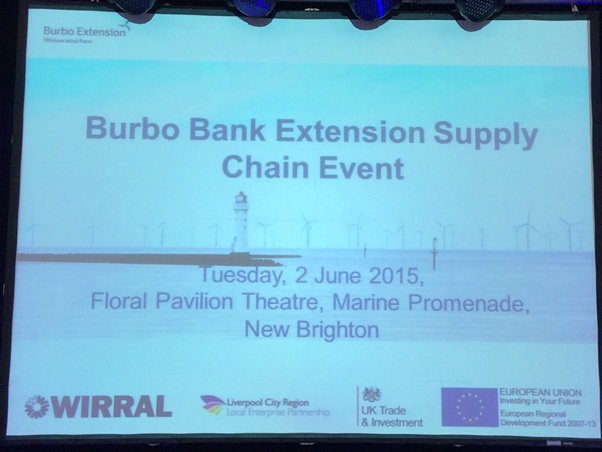
Burbo Bank supply chain event
This partnership approach to creating local supply chains has been developed further still on the Burbo Bank Extension project. The LEP and local partners have been working with DONG Energy and their seven Tier One suppliers to actively pursue opportunities that Liverpool City Region companies were qualified for or could be assisted to achieve qualification to become a supplier. This involved a staged process, firstly outlining the potential opportunities, followed by focused Tier One supplier days and specific workshops on areas such as accessing contract bids through e-procure systems. Several companies that won Gwynt y Mor contracts including Hughes Sub Surface Engineering, now part of James Fisher Group and Bibby Hydromap won contracts for Burbo Bank alongside new suppliers such as ABB, Hutchinson Engineering and Warford from Halton.
This approach has subsequently been adopted for all of DONG Energy’s windfarm developments. Burbo Bank is the first of a series of windfarms being developed by DONG Energy. Alongside Walney off Barrow and Hornsea off the Humber DONG are investing over £6bn into the Northern Powerhouse area over the next five years. We are working in partnership with Cumbria and Humber LEP’s and DONG to maximise the benefits and opportunities for our respective companies. They follow the opportunities across the M6/M62 corridor and we as LEP’s need to provide consistent support mechanisms to them.
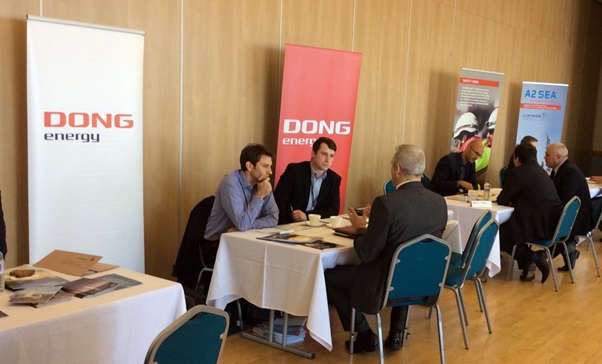
Burbo Bank supply chain event
Whilst understandably the focus is always on the wind turbines there is a huge spectrum of work packages that our companies can and have bid for. For every Pound spent on a turbine a similar amount is spent on getting the electricity from the turbine to the shore. Companies such as ABB at Daresbury provide HVDC systems and integration, Enspec in St Helens provide digital harmonics and Centriforce in Liverpool take plastic bottles and recycle them into armouring for cables. Local companies across a spectrum of business areas such as legal and financial services, marine logistics and port operations, health and safety systems, coatings and lubricants, underwater systems, training and certification, fabrication and specialist assembly and digital mapping and hydrology have all won contracts from the offshore wind sector in the past five years. The LEP continues to assist companies with specialist market knowledge, networking and business support programmes. One of the critical elements of placing companies into the supply chain has been identifying customers. Companies have heard of DONG Energy but most will never supply anything to them directly.
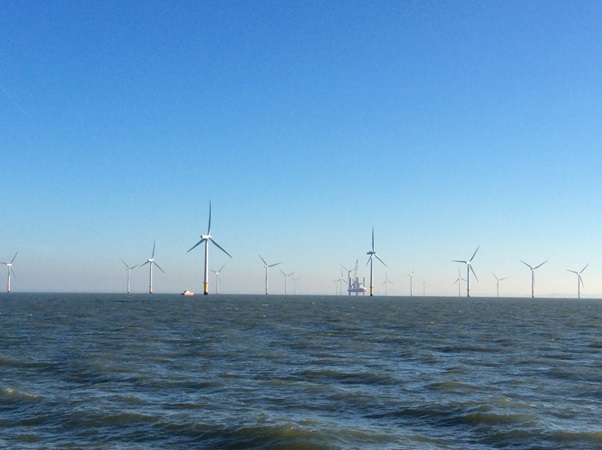
Burbo Bank Extension construction, Spring 2017
So, we are making progress. What’s next? There are three keys aspects for future offshore wind work: Export potential, operations and maintenance and floating turbines.
We have the world’s biggest market for offshore wind with the largest number of turbines deployed and in planning including the world’s largest here in Liverpool Bay. We need to support our companies to take the expertise and products they have developed and secure contracts in emerging overseas markets. A number of our companies have recently secured contracts in France, Germany and significantly, Denmark. This, in Wind terms is taking coals to Newcastle. DONG Energy has recently opened offices in Boston and Taipei to support their expansion into these emerging markets. The largest investors in the US wind market are the global tech companies such as Google and Apple. Tech is extremely power hungry and not very green. They see offshore wind as a technology to address this.
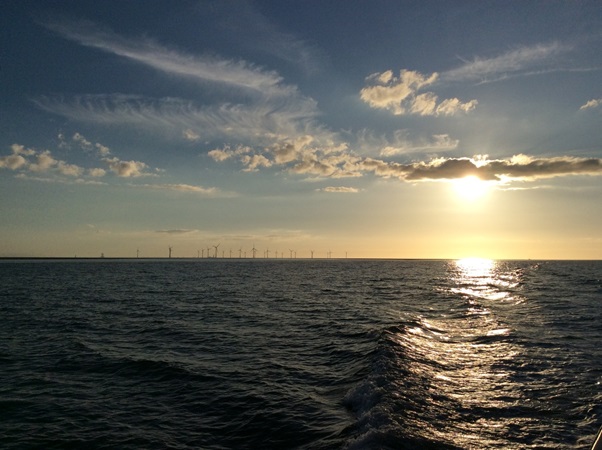
Liverpool Bay
A huge number of organisations are involved in the dramatic construction and installation phase. Once installed, what remains are hundreds of turbines that need constant care and maintenance. Operation and Maintenance is the unsung opportunity for many local companies to build a sustainable future in the wind industry. The latest manifestation of this opportunity is coming out of the ground next to the Seacombe ferry terminal. DONG Energy are building a new operations and maintenance base for their Liverpool Bay windfarms at Kings Wharf. This will go live later in the summer. A majority of the staff have been recruited locally, including a specific focus on ex-services personnel.
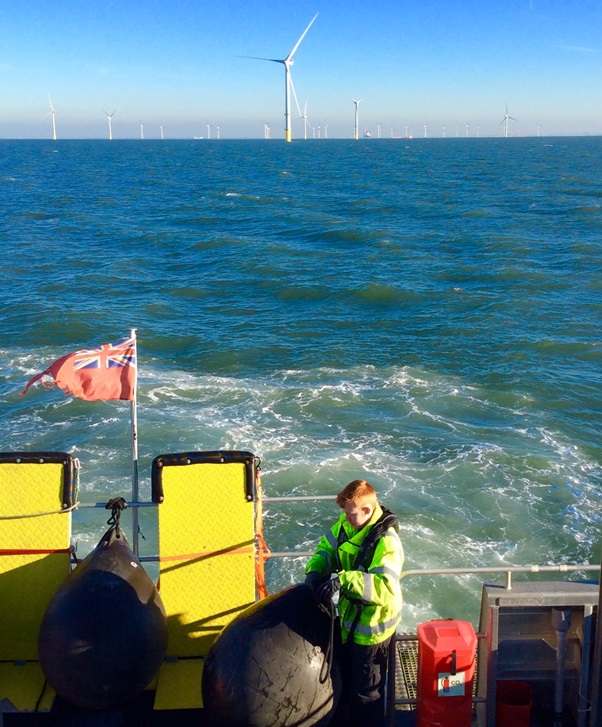
Crew Transfer Vessel cadet, Liverpool Bay
One of the main reasons for number of windfarms appearing around the UK coast is the proliferation of sandbanks. Existing turbines need to driven into a solid foundation. This is fine for the East Coast were the North Sea is shallow to areas of sandbanks over 100 miles from shore. One look at the map shows you that on the West Coast the water turns very deep blue very close to shore. Further development here and in new markets such as around the Pacific Rim will require floating wind turbines to alleviate this issue. It is early days, but demonstration projects in Scotland and Japan are moving at a pace. These structures could be produced much further from final deployment and sailed into position. This change in approach would mirror what happened in the development of North Sea oil platforms. We need to ensure that our companies are ready for this next advance and harness the expertise within our universities and research institutions.

So, as the media descend on Liverpool Bay this week, for the inauguration of Burbo Bank Extension, it’s time to celebrate how far we have come, but more importantly to get excited about the opportunities that are opening up to our City Region. The turbines in Liverpool Bay have become part of the landscape. Love them or loathe them, they place our City Region right at the forefront of a global energy revolution. The influx this week of investors, suppliers, media and government officials should remind us we’re at the forefront of this young and dynamic industry and of the huge opportunity we have, working together, to make Liverpool City Region the largest renewable marine energy hub in Europe.
Mark Knowles, Head of Low Carbon Economy, Liverpool City Region LEP
Header image courtesy of DONG Energy
